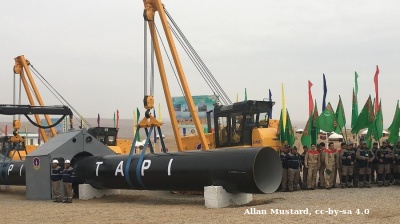CENTRAL ASIA BLOG: Tajikistan plays role as one of world’s pre-eminent water diplomats at glacier summit, but Rogun dam remains a hard sell

In Dushanbe’s gilded, chandelier-adorned hall of Kokhi Somon, the “crème de la crème” of the world’s glacier experts gathered to discuss the melting of giant ice sheets in mountain ranges around the world, brought about by the climate crisis.
Some 2,200 participants from 65 countries and 70 international organisations, including heads of state from every continent, vice-presidents, ministers, scientists and representatives of the United Nations and civil society, gathered in the Tajik capital between May 29 and 31 to attend a major event, the High-Level International Conference on Glaciers' Preservation.
Such a special occasion is a rare thing in Tajikistan, a small, poor and mountainous country in Central Asia, and a country where the glacier crisis is already all too real.
Tajikistan is indeed one of the most impacted countries in the world when it comes to melting glaciers. It had as many as 14,000 glaciers or more—but around 1,000 have disappeared over the past 150 years. Looking at the past 50 to 60 years, the ice giants in the Tajik mountains have shrunk by 20% in volume and 30% in area.
The reason for the glacier destruction was immediately clear to conference participants when they stepped off their planes at the end of May in the 30-degree heat of Dushanbe: the country's average annual temperature has been rising steadily, and has warmed by between 0.7 and 1.9°C in 65 years.
Tajikistan’s glaciers are melting inexorably, yet they are supposed to supply water to over 70mn people in Central Asia. Sentences to the effect of “projections indicate a loss of more than half of them by 2050” were heard over and over again during the three-day conference. This plight faced by Tajikistan and Central Asia was as good a starting point as any other.
Two decades of water conferences
The growing crisis very much explains why Tajikistan has put so much effort into raising concern for glaciers, and for water security in general.
For this conference, which sounded the alarm bells for both water and food security in various geographies, Tajikistan pulled out all the stops. Throughout the city of Dushanbe, billboards and posters displayed the blue-and-white conference logo, side by side with the portraits of President Emomali Rahmon—the leader who has been in power since the country's independence in 1992—that decorate the streets.

Celeste Saulo, secretary-general of the UN's World Meteorological Organization, with Emomali Rahmon, President of Tajikistan, at the glacier summit (Credit: WMO).
His activism on glaciers was in fact nothing new: as early as 2003, Rahmon pushed for the UN to declare that year the “International Year of Freshwater”. Also on Dushanbe's initiative, a number of conferences have been organised on the disappearance of glaciers, during which Tajikistan's vision of water management and regional cooperation has been presented to participants.
In 2010, the International Conference on Water Cooperation was held in Dushanbe as part of the International Decade for Action 'Water for Life' 2005-2015”. In 2018, the Tajik government initiated the International Decade of Action “Water for Sustainable Development 2018-2028”.
"What they've managed to do is quite exceptional; they're almost competing with the Netherlands, another country strong in water diplomacy, for geographical reasons; it's literally built on water. The initiatives launched by Tajikistan over the last 20 years have been very successful at the United Nations level," said Filippo Menga, associate professor of Geography at the University of Bergamo in Italy, and editor-in-chief of the journal Political Geography. Menga has long worked on Tajikistan's water issues.
Behind water concerns, the Rogun project
Menga also noted that “there are a lot of economic interests behind all this diplomacy”. According to him, the “Tajik government started to get active [in international water issues], because it wanted to build the world's biggest dam”, which is none other than the Rogun hydroelectric dam, a titanic project with a current estimated cost of around $8bn, or more than half the Tajikistan's annual GDP.
The support of international donors and foreign public and private players is indispensable to the Rogun megaproject. From the Italian company “We Build” (formerly Salini) to French, Austrian and Iranian companies, plenty of actors are involved in the implementation and studies. Significant financial support seems set to come from international financial institutions (IFIs) including the World Bank, the Asian Development Bank (ADB) and others, while the European Investment Bank (EIB) is also working on plans to invest.
But Dushanbe still hasn't secured enough money to complete the financing. So during water summits and conferences, Dushanbe constantly reminds people of its flagship project.
At various stands in the Kokhi Somon Palace for the glacier conference, between stands displaying interactive maps of glaciers, outlining technologies and plans for preserving their environment, a massive place was reserved for the Ministry of Energy. In front of running promotional videos for the Rogun hydropower plant (HPP), ministry officials were there to explain to conference participants this “multilateral project, which will produce 100% green energy, enabling the country to achieve energy sufficiency”.
A “blue washing” strategy for Tajikistan ?
The project is particularly close to the heart of President Rahmon: a whole patriotic culture, and even songs, have grown up around the giant ambition, which if realised to the full extent would be the crowning achievement of Rahmon's reign.
However, the Rogun dam is nothing if not controversial, according to several studies, and seemingly goes against the spirit of what the Tajik government itself is promoting in terms of sustainable water management.
Experts point to the exorbitant cost of the project in relation to the country's GDP, and the disastrous consequences that could be witnessed in the event of an earthquake or accident: as many as two million people could be drowned if its 13.3bn cubic metres of reservoir water were to be released in a surge into the wild.
On February 24, two citizens from Uzbekistan and Turkmenistan, accompanied by the environmental coalition “Rivers without boundaries” based in Kazakhstan, filed a request for inspection against the World Bank, which has approved a feasibility study for the project. The plaintiffs pointed out that the implementation of the Rogun dam would reduce the flow of the Amu Darya River by 25% given the size of the reservoir, and that this reduction could aggravate desertification and soil salinisation in downstream agricultural areas, affecting between eight and 10 million people in Turkmenistan and Uzbekistan.
“It's extremely good that Tajikistan is organising such events [as the glacier conference]," reflected a member of a Central Asian NGO working on water issues, who preferred to remain anonymous. “These things are a step in the right direction. But it's always the same: little comes out of these conferences and the fine speeches. What's more, where there's a disconnect with what the country is saying and doing, is the lack of consideration internally for renovating irrigation canals. We can see that this crucial issue is not taken seriously enough".
According to a Eurasian Development Bank study published in 2023, "it is crucial to organise rigorous water accounting at the level of inter-farm canals and farms, with the participation of water user associations (WUAs).
“In Central Asia, around 40% of the water taken from rivers is lost through filtration in the canal network; a third is lost in the main and inter-farm canal networks, and two-thirds of losses occur in the farm canals”.
Meanwhile, Rahmon continues to showcase his “blue diplomacy” around the world. He’s attending the UN World Water Conference in Nice, France, between June 9 and 13.


